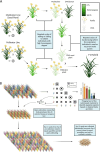Genetics, genomics and breeding of fennel
- PMID: 40335931
- PMCID: PMC12057180
- DOI: 10.1186/s12870-025-06608-5
Genetics, genomics and breeding of fennel
Abstract
Fennel (Foeniculum vulgare Mill. or Anethum foeniculum) stands out as a versatile herb whose cultivation spans across various regions worldwide, thanks to its adaptability to diverse climatic conditions. Its economic importance is mainly due to its numerous pharmaceutical properties and its widespread use in culinary applications. In this review, we first reviewed the chemical composition of this species, stressing the importance of two volatile compounds: t-anethole and estragole. The few cytological and genetic information available in the scientific literature were summarized. Regarding this latter aspect, we pointed out the almost complete absence of classical genetic studies, the lack of a chromosome-level reference genome, and the shortage of adequate transcriptomic studies. We also reviewed the main agronomic practices, with particular emphasis on breeding schemes aimed at the production of F1 hybrids and synthetic varieties. The few available studies on biotic and abiotic stresses were discussed too. Subsequently, we summarized the main studies on genetic diversity conducted in fennel and the available germplasm collections. Finally, we outlined an overview of the main in vitro regeneration techniques successfully applied in this species.
Keywords: Biochemistry; Breeding; Fennel; Genetics resources; Genomics; Molecular markers.
© 2025. The Author(s).
Conflict of interest statement
Declarations. Ethics approval and consent to participate: Not applicable. This study is a review of existing literature and did not involve the collection of new data from human or animal subjects. Consent for publication: Not applicable. No individual person data in any form (including individual details, images, or videos) is included in this article. Competing interests: The authors declare no competing interests.
Figures


Similar articles
-
The leaf transcriptome of fennel (Foeniculum vulgare Mill.) enables characterization of the t-anethole pathway and the discovery of microsatellites and single-nucleotide variants.Sci Rep. 2018 Jul 11;8(1):10459. doi: 10.1038/s41598-018-28775-2. Sci Rep. 2018. PMID: 29993007 Free PMC article.
-
Fennel (Foeniculum vulgare Mill. subsp. piperitum) florets, a traditional culinary spice in Italy: evaluation of phenolics and volatiles in local populations, and comparison with the composition of other plant parts.J Sci Food Agric. 2017 Dec;97(15):5369-5380. doi: 10.1002/jsfa.8426. Epub 2017 Jun 16. J Sci Food Agric. 2017. PMID: 28500688
-
Characterization of key aroma compounds in microgreens and mature plants of hydroponic fennel (Foeniculum vulgare Mill.).Food Res Int. 2024 Dec;197(Pt 2):115229. doi: 10.1016/j.foodres.2024.115229. Epub 2024 Oct 23. Food Res Int. 2024. PMID: 39577927
-
Exploring fennel (Foeniculum vulgare): Composition, functional properties, potential health benefits, and safety.Crit Rev Food Sci Nutr. 2024;64(20):6924-6941. doi: 10.1080/10408398.2023.2176817. Epub 2023 Feb 19. Crit Rev Food Sci Nutr. 2024. PMID: 36803269 Review.
-
Foeniculum vulgare Mill: a review of its botany, phytochemistry, pharmacology, contemporary application, and toxicology.Biomed Res Int. 2014;2014:842674. doi: 10.1155/2014/842674. Epub 2014 Aug 3. Biomed Res Int. 2014. PMID: 25162032 Free PMC article. Review.
References
-
- Abdellaoui M, Bouhlali E, dine T., Derouich, M., and El-Rhaffari, L. Essential oil and chemical composition of wild and cultivated fennel (Foeniculum vulgare Mill.): A comparative study. S Afr J Bot. 2020;135:93–100. 10.1016/j.sajb.2020.09.004.
-
- Abdollahi MR, Kianersi F, Moosavi SS, Dastan D, Asadi S. Identification and Expression Analysis of Two Genes Involved in the Biosynthesis of t-Anethole in Fennel (Foeniculum vulgare Mill.) and Their Up-Regulation in Leaves in Response to Methyl Jasmonate Treatments. J Plant Growth Regul. 2023;42:759–70. 10.1007/s00344-022-10583-8.
-
- Afifi SM, El-Mahis A, Heiss AG, Farag MA. Gas Chromatography-Mass Spectrometry-Based Classification of 12 Fennel (Foeniculum vulgare Miller) Varieties Based on Their Aroma Profiles and Estragole Levels as Analyzed Using Chemometric Tools. ACS Omega. 2021;6:5775–85. 10.1021/acsomega.0c06188. - PMC - PubMed
-
- Ahmed AF, Shi M, Liu C, Kang W. Comparative analysis of antioxidant activities of essential oils and extracts of fennel (Foeniculum vulgare Mill.) seeds from Egypt and China. Food Sci Human Wellness. 2019;8:67–72. 10.1016/j.fshw.2019.03.004.
Publication types
MeSH terms
Substances
Grants and funding
- CN00000022/Agritech National Research Center - European Union Next-Generation EU (Piano Nazionale di Ripresa e Resilienza (PNRR)-Missione 4 Componente 2, Investimento 1.4-D.D. 1032 17/06/2022
- CN00000022/Agritech National Research Center - European Union Next-Generation EU (Piano Nazionale di Ripresa e Resilienza (PNRR)-Missione 4 Componente 2, Investimento 1.4-D.D. 1032 17/06/2022
- CN00000022/Agritech National Research Center - European Union Next-Generation EU (Piano Nazionale di Ripresa e Resilienza (PNRR)-Missione 4 Componente 2, Investimento 1.4-D.D. 1032 17/06/2022
LinkOut - more resources
Full Text Sources

